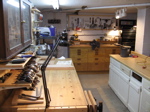click the pictures for larger shots
Interesting little project sent my way from one of my friends at Woodnet , T.J. Mahaffey , and one close to my heart. Scraper planes...gotta love 'em..no matter what shape they're in.
these all had good bones...solid castings, good wood, good mechanicals and with the exception of the hardest one to find (the 12 1/4) no pitting..more on that later
Real nice handle on the #12..good amount of japanning and solid as a rock
the hard to find 12 1/4 has pitting on the sides, sole, and bed, not much japanning and the wrong outer nut..what to do? Rare plane but not in this condition..total re-hab or just get it back into working order...???
You got to love these 112's, one of the best designed scraper plane and the easiest to use..good japanning..tote excellent, knob a little beat up and the inner adjusting nut frozen in place...
With a little work to just lightly clean, so I can see what else may be a problem, they're starting to look pretty good...toothbrush, scrubby pad and Greased Lightning cleaner tend to do a good job. Real good solid user planes.
now I can see where the problems may lie. The 12 and the 112 have more than adequate japanning, as I said, good solid bones....that little 12 1/4 though, it's in sad shape...
just a little more work, a good wood cleaning and a coat of polishing compound and wax for the 12 and 112, but a complete strip down for the 12 1/4
Next step...LINK
Scraper project page two
click the pictures for larger shots
Let's start with the nicest one..certainly the easiest to deal with. First I let it soak in a bath of PB Blaster to loosen up all the pivot points, cleaned again with Greased Lightning, then polished up the sides and the sole. A little polishing compound and a hard paste wax for the japanning brought that back to life. I really like the light rosewood handle, you don't see many of these.
A good rub down with rottenstone and then a nice coat of buffed on hard beeswax on the handle brought out the grain. There are a few small spots of japanning missing but not enough to warrant a complete re-japanning..a good solid workman tool in excellent shape.
Now comes the No. 112....found a "B" casting mark on this one..1899-1902. A nice old one that has lots of life left. It was the same deal as the 12 really, that frozen inner nut came loose with PB Blaster and time, There was a good solid rosewood tote, knob a bit nicked up and partially destroyed on one side but they both cleaned up nicely. Slight bit of japanning loss on the bed, but again, not enough to challenge the integrity of the original finish. When they're this old and in this nice a shape, you really don't mess with it.
reminds me of my first 112..and I still use that one..
now the real hard part..this one is no where near finished, but it's on the road. The 12 1/4 needed a lot of work . Files, wire wheel, sandpaper, my Dremel tool, dental picks and liberal does of PB blaster took care of the very slight japanning. But I had to go electrical with the pitting on the sole and sides. Stationary belt sander did the job with only three grits of belts. Wood was done as outlined above. Threads on the adjusting rod were damaged with rust but I was able to "chase" them back into shape. Fortunately, I did find an extra original outer nut to replace that wing nut. Mechanically, it works perfectly but it looks weird all shiny metal
Next time you see this one it'll have a new coat of real japanning and should look like a completely different tool
I used real japanning on this one, (libertyonthehudson.com) The Japanning was done in three stages, light coat first...left to dry (actually set out in the sun to heat up)and rubbed out, second heavier coat..same deal then the final light coat rubbed out and waxed. Wish I could dip these things like they were done in the factory, but small soft brushes seem to do almost as good a job.
Some before and afters:
links to individual shots..
links to individual shots..

